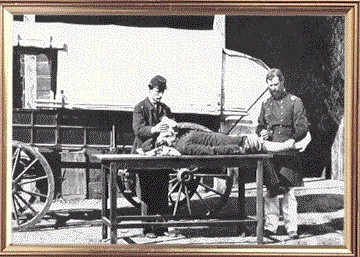Largely predominating on both sides were the wounds inflicted by the rifled musket, carrying its conical ball of an ounce or more in weight. These wounds differed in some important and very material characteristics from all gunshot wounds in preceding wars, including that with Mexico ; as well as those in our later experience with Spain, and those inflicted by the improved army-gun of the present day. The old round ball, of low velocity, caused many fractures in bones of the extremities. But it never produced such shattering, comminution, and amount of bone destruction and injury as did the heavy conical ball of increased velocity-both differing in character from the Mauser and Martini of the present day with their still greater increase of velocity-and its hardened or steel-jacketed projectile of smaller caliber, which often makes an almost clean-cut perforation, even through the shaft of a long bone.
The shattering, splintering, and splitting of a long bone by the impact of the minie or Enfield ball were, in many instances, both remarkable and frightful, and early experience taught surgeons that amputation was the only means of saving life. In the vicinity of a joint, the ends of the bone being more spongy, softer, and less brittle, the damage to the shaft of the bone was not so great, and the expedient of resection, largely resorted to and greatly developed by the surgeons, in many instances afforded a comparatively, if not perfectly, restored limb. Resections of the upper extremity afforded better results than those of the lower, although fairly good results were sometimes obtained in the case of the latter.
In some instances, I deemed it imperatively necessary to resort to a second, or even a third resection of the limb, even after the end of the bone had been sawn through, and while the patient was still under the influence of the anesthetic, the primary section furnishing the information that the bone had been shattered, splintered, or split higher up than could be ascertained at first. Conservative surgery was, I might say, almost, if not entirely, a universal principle with the Confederate surgeon; conservatism, first, as to the life of the wounded soldier, secondly, as to his future comfort and usefulness.
Conical-hall wounds in the abdomen were nearly always fatal, far more so than those produced by the round ball with lower velocity. The intestines, in the former case, were generally perforated; in the latter, they often escaped this injury by being pushed aside by the slower moving round ball fired from the smooth-bore gun. The reverse of this was the case in wounds of the chest, since the round ball bruised and lacerated a large area of lung tissue, while the more swiftly moving conical ball often produced a clean-cut wound.
Source: "The Photographic History of the Civil War" Volume IV, article by Deering J. Roberts, M.D., Surgeon, Confederate States Army









